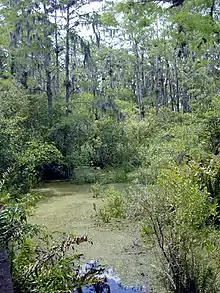
A swamp is a wetland that is forested. Many swamps occur along large rivers where they are critically dependent upon natural water level fluctuations. Other swamps occur on the shores of large lakes. Some swamps have hammocks, or dry-land protrusions, covered by aquatic vegetation, or vegetation that tolerates periodic inundation. The two main types of swamp are "true" or swamp forests and "transitional" or shrub swamps. In the boreal regions of Canada, the word swamp is colloquially used for what is more correctly termed a bog or muskeg. The water of a swamp may be fresh water, brackish water or seawater. Some of the world's largest swamps are found along major rivers such as the Amazon, the Mississippi, and the Congo.
Swamps are characterized by slow-moving to stagnant waters. They are usually associated with adjacent rivers or lakes. Swamps are features of areas with very low topographic relief.
Historically, humans have drained swamps to provide additional land for agriculture and to reduce the threat of diseases borne by swamp insects and similar animals. Many swamps have also undergone intensive logging, requiring the construction of drainage ditches and canals. These ditches and canals contributed to drainage and, along the coast, allowed salt water to intrude, converting swamps to marsh or even to open water. Large areas of swamp were therefore lost or degraded. Louisiana provides a classic example of wetland loss from these combined factors. (Full article...)